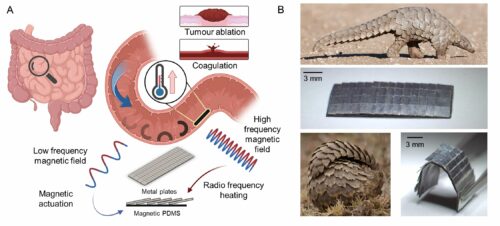Researchers at the Max Planck Institute for Intelligent Systems have developed a flexible robot resembling a Pangolin, capable of quick sphere transformation and heat emission.

Pangolins are fascinating creatures. They resemble walking pine cones due to their unique characteristic of being the only mammals entirely adorned with rigid scales. These scales, composed of keratin like our hair and nails, form an overlapping pattern that directly attaches to the underlying supple layer of skin. This remarkable configuration enables pangolins to roll into a protective ball when facing threats.
Researchers from the Physical Intelligence Department at the Max Planck Institute for Intelligent Systems in Stuttgart have created a flexible robot using a combination of soft and hard materials, mimicking the Pangolin’s ability to transform into a sphere instantaneously with an additional feature that the robot can emit heat when needed.
The researchers have introduced a compact robot design measuring two centimetres in length. This robot comprises two layers, a soft layer crafted from a polymer embedded with tiny magnetic particles and a hard layer constructed from metal elements arranged in overlapping patterns. Despite being composed of solid metal components, the robot retains its softness and flexibility, making it suitable for internal applications within the human body. By subjecting the robot to a low-frequency magnetic field, the researchers manipulated its movement, causing it to roll up and move in the desired direction. Resembling the scales of the Pangolin, the protruding metal elements of the robot operate harmlessly within the surrounding tissue. Once rolled up, the robot can effectively transport particles like medications.
The envisioned future involves deploying miniature machines to navigate bodily systems like the digestive tract. Upon exposure to a high-frequency magnetic field, the robot harnesses its embedded metal components to generate heat exceeding 70°C. This thermal energy finds application in various medical procedures, including treating thrombosis, hemostasis, and tumour tissue removal. The rarity of untethered robots constructed with rigid materials like metal that possess the ability to emit heat, coupled with their unrestricted mobility, makes the pangolin-inspired robot highly promising for advancements in modern medicine.
The future holds the potential for the pangolin-inspired robot to navigate the most narrow and delicate areas of the human body in a minimally invasive and gentle manner. With the ability to emit heat when necessary, this vision foresees a remarkable advancement in medical technology.
Reference: Ren Hao Soon, Zhen Yin, Metin Alp Dogan, Nihal Olcay Dogan, Mehmet Efe Tiryaki, Alp Can Karacakol, Asli Aydin, Pouria Esmaeili-Dokht, Metin Sitti. Pangolin-inspired untethered magnetic robot for on-demand biomedical heating applications. Nature Communications, 2023; 14 (1) DOI: 10.1038/s41467-023-38689-x





